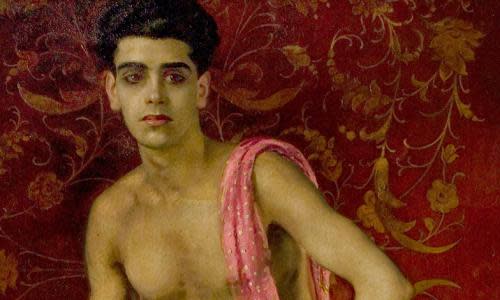The Great British Art Tour: a dazzling young man who commands attention

William Bruce Ellis Ranken was a Scottish-born aesthete and painter known for his sumptuous interiors and elegant portraits of Edwardian society figures. Hibiscus Flower, painted around 1922, is a luminous celebration of male beauty and the male gaze. At nearly two metres tall in its frame, its scale and palette of dazzling colours command attention.
The painting was in the artist’s own collection when he died in 1941 but, frustratingly, we do not know who the sitter is.
Intriguingly there are two other Ranken portraits of a very similar looking man in public collections. One, is the suited Portrait of a Young Man (Young Man Sitting With Left Foot Across Right Knee) at the Russell-Cotes Art Gallery and Museum. The other, Portrait of An Anglo-Indian Student, is in the collection of Northampton Museums and Art Gallery and bears an even more striking resemblance to the subject of Nottingham’s painting; it shows the sitter in a more conventional shirt and jacket, holding a book. Could this be a portrait of the same man, painted in an early session (almost as a preparatory painting) and later worked up into the Hibiscus Flower portrait?
Ranken’s sister suggested that he might be the British ballet dancer Sir Anton Dolin – Ranken had painted him previously and she thought there was a likeness.
Whoever the sitter might be, it draws on the European tradition of paintings of partially clothed or nude women depicted in harems, favoured by 19th-century orientalist artists such as John Frederick Lewis (1804–1876) and Charles Knighton Warren (born 1856). Orientalist art propagated a European myth of the east as romanticised. Such images evolved into influential stereotypes that still support racist notions today. What is perhaps unusual with Hibiscus Flower is that, instead of a woman, we see a bare-chested young man – in green, gold-belted pantaloons against a background of elaborate, gilded red wallpaper. He holds the eponymous flower and sits in a casual pose, a pink scarf flecked with gold falling from his shoulder to spiral on the seat beside him. Because he is not named it adds to the sense of him being presented as an “exotic” ornament sitting in an enchanting interior.
The portrait was given to Nottingham City Museums and Galleries by Ranken’s sister Janette five years after his sudden death at 59 from a brain haemorrhage. Janette gifted more than 200 of her brother’s works to public galleries and museums, and his works can be seen today across the UK, from Belfast to Blackburn and Bournemouth.
• You can see more art from Nottingham City Museums and Galleries on Art UK here, and find out more on the museums’ website.
• This series is brought to you in collaboration with Art UK, which brings the nation’s art together on one digital platform and tells the stories behind the art. The website shows works by 50,000 artists from more than 3,000 venues including museums, universities and hospitals as well as thousands of public sculptures. Discover the art you own here.

 Yahoo Movies
Yahoo Movies 